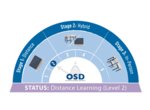

The Olympia School Board met yesterday evening at 6:00 p.m. to reflect on the latest in-person learning guidance issued by Gov. Jay Inslee and the Wash. Department of Health.
Since September 21, the district moved to Distance Learning Level 2 when it began in-person learning at 10 schools for groups of no more than five students.
Since the governor’s latest guidance on December 16, the Board has begun planning for the transition to Level 3, a hybrid learning environment.
Reopening Plan
The reopening plan for hybrid learning places a larger focus on remote learning given the way things started at the beginning of this school-year. This hybrid schedule would separate the student population into A/B cohorts, with each cohort returning to in-person learning for two separate days of the week and setting aside Wednesdays as a remote-learning day for both cohorts.
Discussing the framework for reopening, Superintendent Patrick Murphy placed specific emphasis on one point from Gov. Inslee’s latest guidance. “This framework can assist local health officers in guiding and school administrators in deciding whether to resume, expand, or reduce in-person instruction for public and private K-12 schools during the COVID-19 pandemic. We make those decisions but the county health officer has the right to stop instruction as they see fit if something comes up. I find this important to clarify,” said Murphy.
Murphy also clarified the question all parents are asking, ‘When are we going to have kids back in school?’ Responding with, “We currently do. Right now, we have 392 students being served in our schools during distance learning. Broken down, two-thirds of these students are from special education programs and one-third from non-special education backgrounds,” stated Murphy.
Murphy also addressed the ongoing mental health crisis due to students’ continued remote learning, stating that the key question now is, “How can we put students back in schools while keeping them COVID-19 safe?”
In providing a tentative answer to this question, Murphy referenced multiple results from the mental health and progress survey done in October for grades 6-12 with 3,000 responses out of the student population of 5,500. Results included: students’ decreased confidence in completing their work on-time and overall mentality during remote learning.
Additionally, Murphy addressed current F (failure) and incomplete rates, stating the many ongoing opportunities the district is offering to students in the hopes of decreasing these numbers.
These include:
Murphy also clarified that incomplete grades are not calculated into a student’s GPA until that class is officially completed. However, it does stay on their transcript, even if the grade is eventually made up.
“Some people say an incomplete grade reflects badly, but I have talked to college recruiters that say it actually shows a student’s effort and resilience,” said Murphy.
Racial Equity
The remainder of the meeting was dedicated to a racial equity engagement and planning presentation put forth by two members of the Puget Sound Education School District (PSESD), Eileen Yoshina and Matthew Gulbranson.
A key talking point was the importance of acknowledging native land and native people. “This is not just a check-the-box moment, it is an opportunity to reflect on what this really means and what our relationships are like with members of that community,” said Yoshina.
Another reflection point included an important tool in the tool box of racial equity: a community agreement. “This agreement is not just important to reference when conflict arises, but before opening up the conversation as well,” said Yoshina.
Key points included:
Regarding the ongoing conversation that equity brings, Gulbranson said, “This is not something that is going to be solved in the next day, or even the next year. This is an ongoing journey. We need to balance the urgency and keep moving forward in our work.”
Comments
No comments on this item Please log in to comment by clicking here